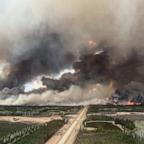What to know about calculating breast cancer risk after Olivia Munn's diagnosis
The actress opened up about a year-long private battle with breast cancer.
Olivia Munn's revelation that she is battling breast cancer put an important spotlight on a tool used to help determine a person's risk of the disease.
The "X-Men: Apocalypse" actress, 43, revealed in an Instagram post Wednesday that she was diagnosed with breast cancer last year and has undergone four surgeries, including a double mastectomy, in the months since her diagnosis.
In her post, Munn credited her doctor with saving her life by calculating her breast cancer risk assessment score.
"Dr. Aliabadi looked at factors like my age, familial breast cancer history, and the fact that I had my first child after the age of 30," Munn wrote. "She discovered my lifetime risk [of breast cancer] was at 37%. Because of that score, I was sent to get an MRI, which led to an ultrasound, when then led to a biopsy. The biopsy showed I had Luminal B cancer in both breasts."

Munn described her cancer as "aggressive" and said without her doctor's help, the cancer may not have been discovered for another year.
The Breast Cancer Risk Assessment Tool that Munn spotlighted is a critical tool in helping doctors calculate a patient's lifetime risk of breast cancer, according to Dr. Jennifer Ashton, ABC News chief medical correspondent and a board-certified OBGYN and obesity medicine physician.
Here are five questions answered about the tool.
1. What does the Breast Cancer Risk Assessment Tool calculate?
The tool uses personal information including age, family history of breast cancer, date of first menstruation, and whether or not you've ever given birth to help estimate your risk of developing breast cancer
"It helps to provide an actual numerical risk for lifetime risk of breast cancer and breast cancer diagnosis in the next five years," Ashton said. "It is what we use in medicine to stratify a woman's individual risk in a more precise way."
The tool is based on a statistical model known as the Gail Model, which is named after Dr. Mitchell Gail, senior investigator in the Biostatistics Branch of the NCI Division of Cancer Epidemiology and Genetics, according to the National Institutes of Health.
2. Does the tool diagnose cancer?
While the tool may help a doctor estimate your breast cancer risk, it cannot tell you whether or not you will get breast cancer.
In general, a score of over 20% on the tool will prompt a recommendation for additional breast cancer screening.
3. Is the tool available for everyday people, or just doctors?
The tool is available online through the NIH and is free and available for anyone to use.
However, it is best to talk to your doctor about your cancer risk, rather than try to evaluate it yourself as there may be other things beyond the tool’s input to consider. A provider will also be able to discuss your results and potentially offer further diagnostic testing/screening.
There are also other models that health care providers may use to estimate cancer risk.
4. Are there any limitations with the tool?
The tool does have limitations for some Black women and for women born outside of the United States, particularly women of Hispanic descent, according to Ashton.
The NIH notes the tool may underestimate risk for those women.
In addition, the tool cannot estimate breast cancer risk accurately for women certain genetic mutations such as BRCA1 or BRCA2, or women with a previous history of invasive breast cancer, according to the NIH.
5. What is the latest guidance on breast cancer screenings?
Most women with average risk should start screening for breast cancer at age 40, and get screened every other year through age 74, according to draft guidance updated in 2023 from the U.S. Preventive Services Task Force, a federally appointed group of experts whose conclusions guide medical decision making and determine some insurance policies.

The updated draft guidance dropped the age of screening from 50 to 40 last year, as mounting evidence showed higher rates of breast cancer among women in their 40’s, including a 2% increase from 2015 to 2019.
Breast cancer screening tools include a mammogram, which is an x-ray of the breast. Dense breast tissue may make a mammogram more difficult to interpret, and may make detecting cancer more difficult, according to the NIH.
Women with dense breasts may be called back for follow-up testing, including ultrasound and/or magnetic resonance imaging.
Women at higher risk of getting breast cancer may also receive an MRI scan.







